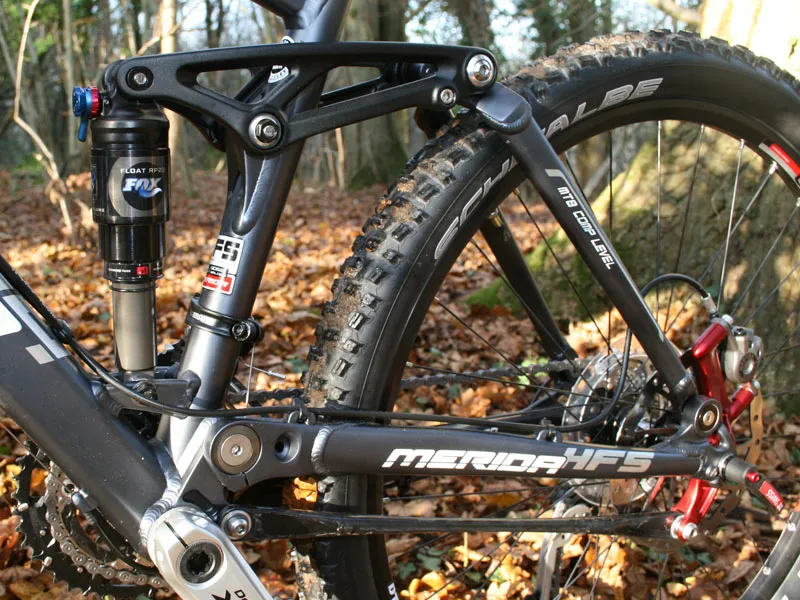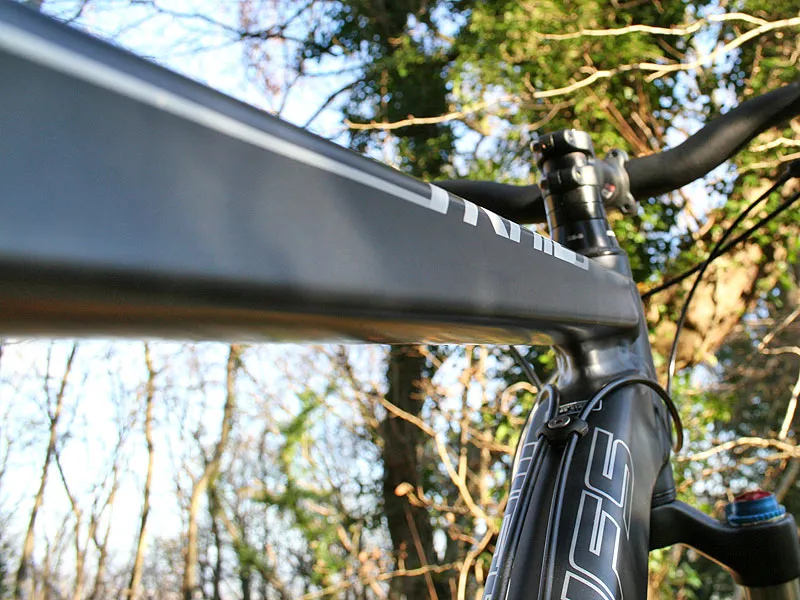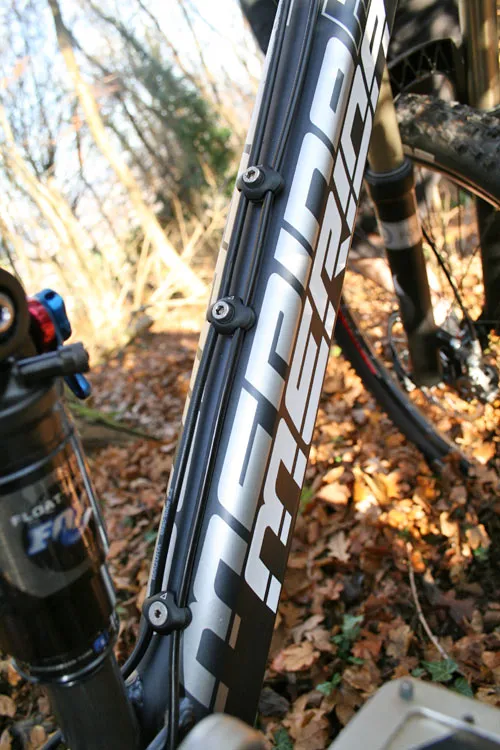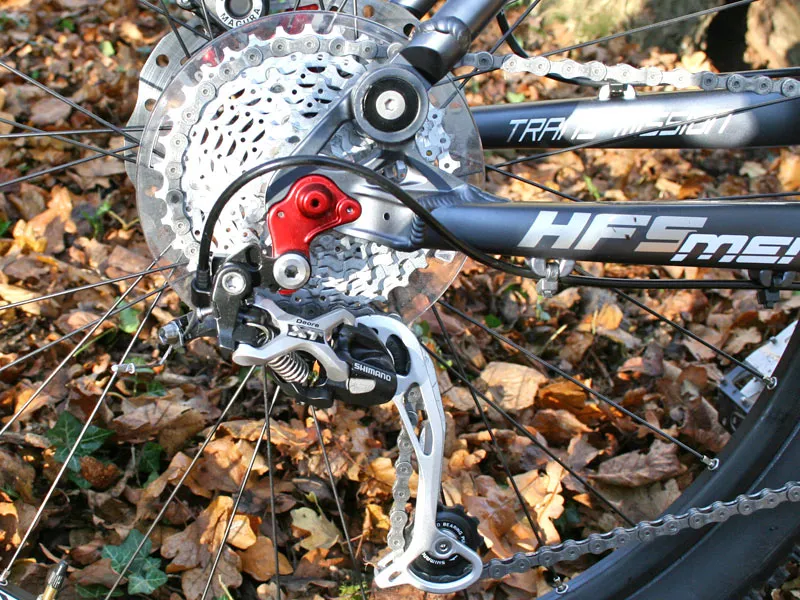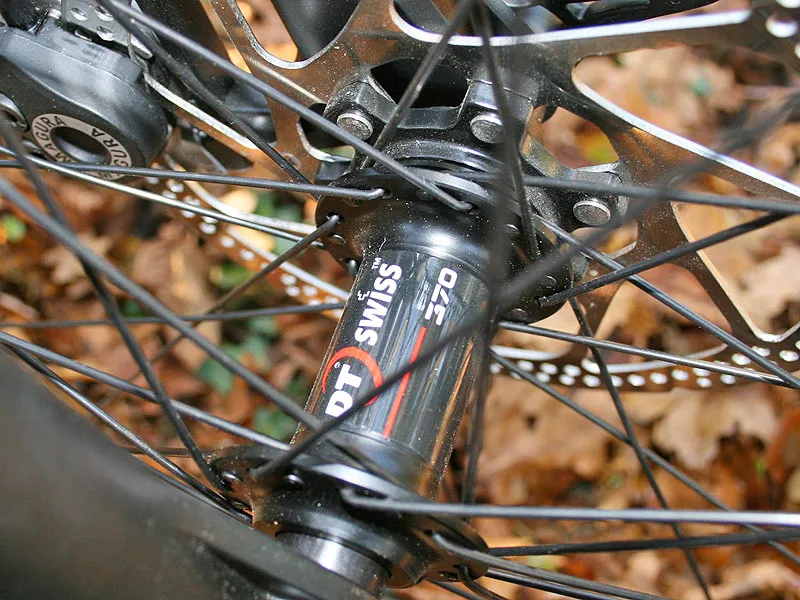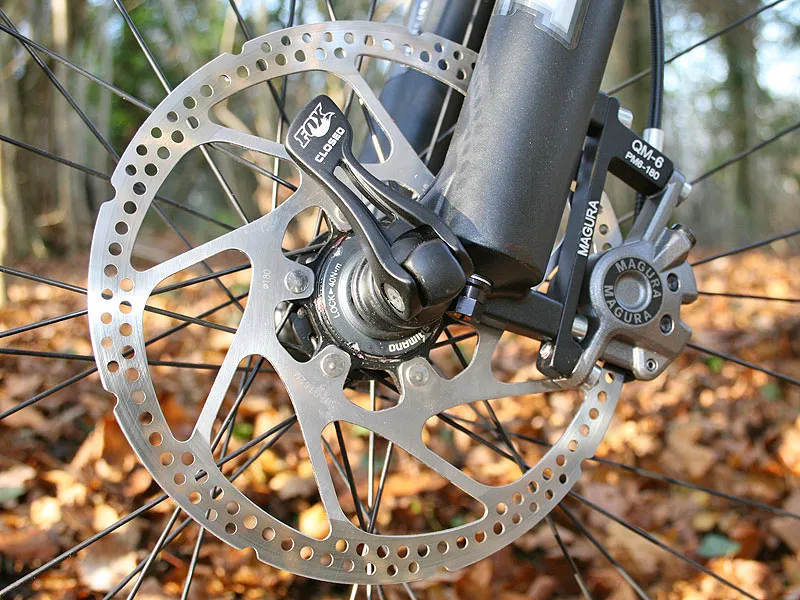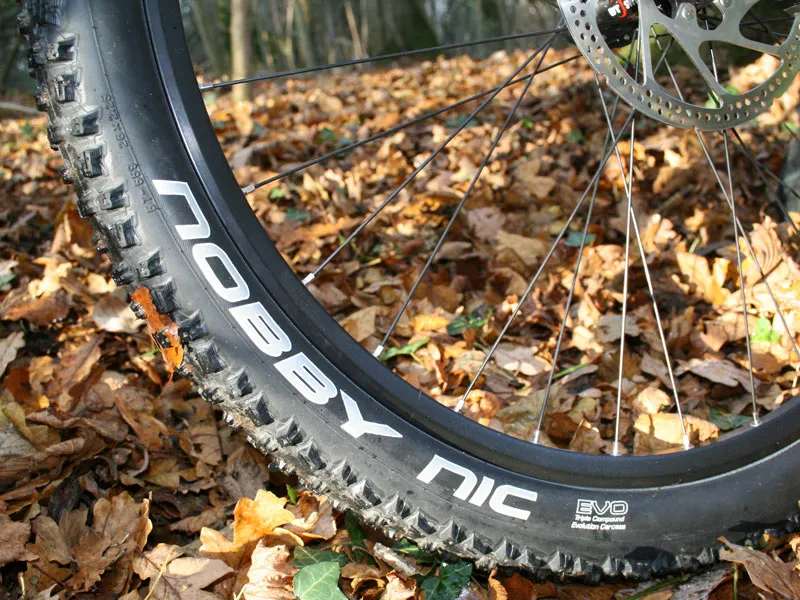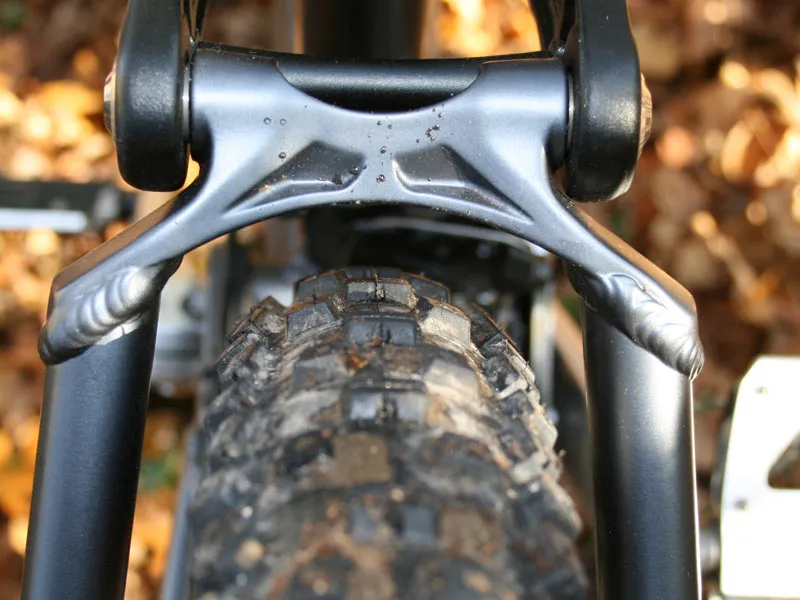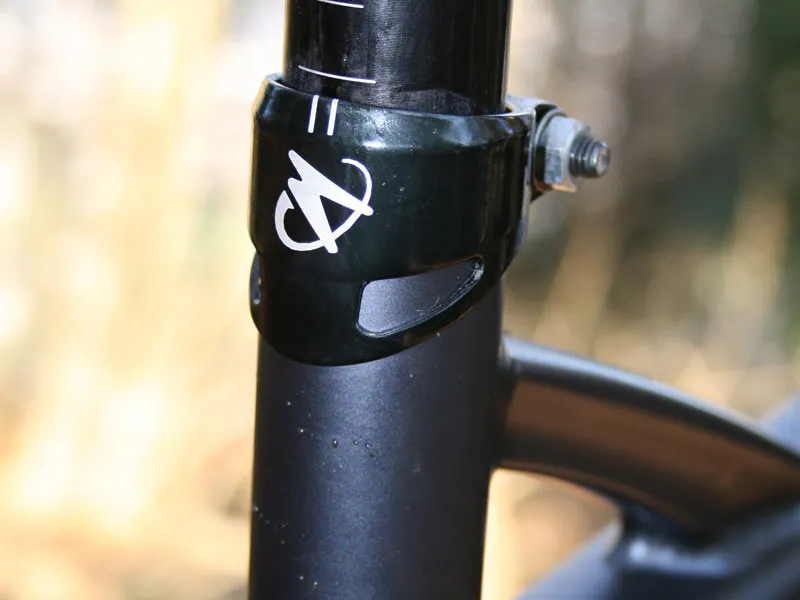Merida are a Taiwanese company who make bikes for some of the biggest brands. They also produce their own range using the same cutting-edge technology, and the Trans-Mission is their 130mm travel cross-country bike, specifically designed for the rigours of UK riding. With a near flawless spec, a unique look and some great features, it looked like a contender for the trail bike crown. But the whole never quite added up to the sum of its parts.
Ride & handling: Stable and neutral, with plush suspension
The Merida is an easy bike to get used to, with neutral handling and high-performance finishing kit. At trail centres like Cwmcarn it lapped up the swoopy singletrack, and the supple rear end provided surprising amounts of traction in the gloopy mud around Bristol.
It's lighter than it looks (28.4lb) and accelerates well, and once we'd got swapped the 120mm stem for a shorter unit, it was surprisingly agile for a bike with this much travel.
The wide riser bars and 15mm front axle make for a stiff front end and accurate steering, and, in combination with the plush suspension, make the Trans-Mission a confident descender.
The one area where it didn’t live up to expectations was on technical climbs, where we found the front end on our large (19in) bike a little high and the cockpit a little cramped.
For a beginner this could be ideal, with the upright position being easy to get used to and boosting confidence on descents, but we prefer a more flat-backed, racer-style position and like to get weight over the front wheel to ensure traction through corners.
The fork has adjustable travel, so if you know a climb's coming you can lower the front end, and this does give a noticeable improvement in low-speed handling. Similarly, turning on a bit of ProPedal platform damping on the rear shock ensures plushness doesn't turn into wallow.
All this means that the bike is definitely one for the fettler who is prepared to experiment with different suspension settings, rather than someone who wants to just jump on and ride.

Frame: Love/hate looks, but you can't fault the attention to detail
The Trans-Mission range begins with the TFS 300-D and peaks with the carbon 3800-D, with the 3000-D second from top. All share the same suspension platform, so what sets them apart, in addition to different spec levels, is the way the frames are made.
The letters HFS in the name signify that the 3000-D is constructed from Merida’s Prolite 66 alloy using hydroforming – a process where hot oil is forced into round tubes at extremely high pressures, pushing the aluminium out against steel moulds and creating radically altered tube profiles. In contrast, the cheaper TFS Trans-Missions are made from ‘Techno Formed’ heat-treated 6061 aluminium.
Every tube on the 3000-D seems to have been manipulated in some way, from the egg-shaped head tube – it bulges in the middle – to the huge, square section tapered down tube. This certainly sets it apart from the pack but, along with the bold white graphics on the matt grey frame, divided opinion in the office, with some loving the high-tech look and others finding it a little OTT.
Out back Merida have gone for a classic four-bar/single pivot hybrid design, with the main pivot placed above and just behind the bottom bracket and two long linkage plates driving the shock. The suspension is supple and progressive.
A pimp looking floating disc brake – with carbon fibre arm and anodised red hardware – keeps the suspension active even when you haul on the anchors, and gives the bike some extra showroom appeal, but had a tendency to rattle at speed. A 10mm DT Swiss RWS ‘thru bolt’ quick-release keeps the rear end stiff, while still allowing the wheel to be removed without tools.
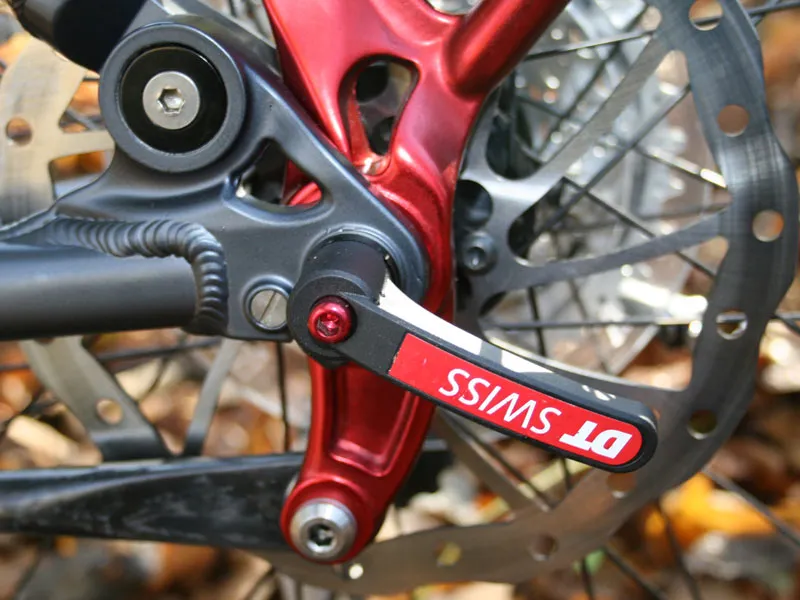
The head tube is fairly long (135mm on our large test bike – it's only 120mm on the smaller sizes but 155mm on the XL) and the conical spacer below the stem further raises the front end of the bike. Combined with the long forks, this means that even after putting the other spacers above the stem, the handlebars are higher than on some 8in-travel downhill bikes, affecting the Merida's climbing and cornering prowess. One solution would be to buy a stem which can be run upside down, thus lowering the bars.
The slack head angle (69.5 degrees) and steep seat tube (73.5 degrees) mean the top tube feels much shorter than its true 595mm length (smaller frame sizes have shorter top tubes), and the angle of the seat tube means that raising your saddle doesn’t increase the reach much. This could be fixed by fitting a longer stem, but handling in other situations would lose out as a result.
Equipment: Near flawless, with benchmark kit from Fox Racing Shox and Shimano.
Fox’s 32 Talas RLC air fork can be switched between three travel settings using a dial at the top of the left leg – 100, 120 or 140mm. The full 140mm of plush bounce was welcome on the downhills and swoopy, rocky singletrack but we found that the bike’s high front end made it essential to wind down the travel on the climbs – otherwise your weight is just too far back, you end up popping involuntary wheelies and it’s difficult to find traction.
This is fine if you’ve stopped for a breather, but annoying if you just want to go for a quick blast and don’t want to have to keep stopping to make adjustments, quick as the system is. There’s a lockout if you need to put some miles in on tarmac. The RP23 air shock is another classy piece of kit, with a smooth stroke and lots of tunability.
The Magura Louise brakes took a while to bed in but offered ample power when they did, while the Shimano XT drivetrain and shifters combine light weight with smooth, predictable changes. The DT Swiss X430 wheels looked good and stayed true.
Saddle choice is always a personal one, but the Fizik Gobi XM was a comfortable enough perch, while the forward-facing seat clamp was ideal for UK riding, reducing the chance of dirt getting inside the frame. The seat clamp on our test bike was a crude nut and bolt arrangement which was difficult to tighten and prone to seatpost slippage, but production bikes will come with an own-brand quick-release.
The only piece of kit we felt compelled to change was the stem – at 120mm on our large (19in) frame, it was just too long for a bike designed to be ridden hard, placing your weight too far over the front – helpful on the climbs, scary on the descents – and spoiling the balance of the bike. We swapped it for a 100mm one and the cockpit felt better instantly. The FSA bars are a good width.
The Schwalbe Nobby NIC 2.25 Evolution tyres are fast rolling and grippier than they look in the mud, but didn't fare well on the wet rocks of our test rides.
